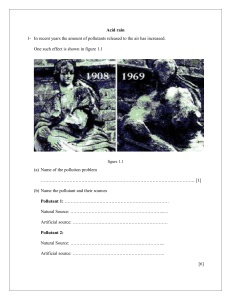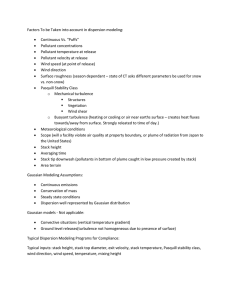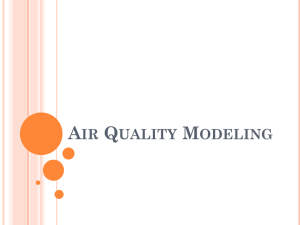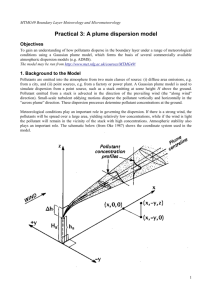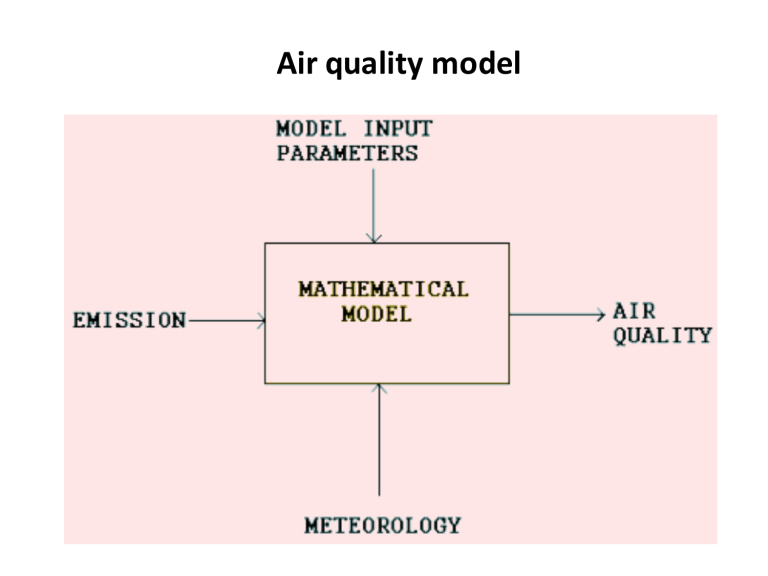
Air quality model Model categories Deterministic approach Deterministic mathematical models calculate the pollutant concentrations from emission inventory and meteorological variables according to the solution of various equations that represent the relevant physical processes. Deterministic approach: Basics • What is Transport ? – It is also termed as advection – Most obvious effect of atmosphere on emission – Advection: implies transport of pollutant downwind of source • • What is Dilution? – It is also termed as “mixing”. – It is accomplished through “turbulence” – Mainly atmospheric turbulence is active What is Dispersion? Dispersion = Advection (Transport) + Dilution = Advection +Diffusion Basic Mathematical Equation Deterministic based AQM The deterministic based air quality model is developed by relating the rate of change of pollutant concentration in terms of average wind and turbulent diffusion which, in turn, is derived from the mass conservation principle. where C = pollutant concentration; t = time; x, y, z = position of the receptor relative to the source; u, v, w =wind speed coordinate in x, y and z direction; Kx, Ky, Kz = coefficients of turbulent diffusion in x, y and z direction; Q = source strength; R = sink (changes caused by chemical reaction). • The above diffusion equation is derived in several ways under different set of assumptions for development of air quality models • Gaussian model is one of the mostly used air quality model based on ‘deterministic principle’ Gaussian plume Dispersion model: Assumptions • Steady-state conditions, which imply that the rate of emission from the point source is constant. • Homogeneous flow, which implies that the wind speed is constant both in time and with height (wind direction shear is not considered). • Pollutant is conservative and no gravity fallout. • Perfect reflection of the plume at the underlying surface, i.e. no ground absorption. • The turbulent diffusion in the x-direction is neglected relative to advection in the transport direction , which implies that the model should be applied for average wind speeds of more than 1 m/s (> 1 m/s). • The coordinate system is directed with its xaxis into the direction of the flow, and the v (lateral) and w (vertical) components of the time averaged wind vector are set to zero. • The terrain underlying the plume is flat • All variables are ensemble averaged, which implies long-term averaging with stationary conditions. Gaussian Plume Dispersion Model Statistical Approach • Statistical models calculate pollutant concentrations by statistical methods from meteorological and emission parameters after an appropriate statistical relationship has been obtained empirically from measured concentration Basis for statistical approach Regression and multiple regression models • Regression models describes the relationship between predictors (meteorological and emission parameters) and predictant (pollutant concentrations) Time series models (Box and Jenkins, 1976) • Time series analysis is purely based on statistical method applicable to non repeatable experiments. • Box-Jenkins approach extracts all the trends and serial correlations among the air quality data until only a sequence of white noise (shock) remains. • The extraction is accomplished via the difference, autoregressive and moving average operators. Box Model • Application : Area source • Principle : (i) It assumes uniform mixing throughout the volume of a three dimensional box. (ii) Steady state emission and atmospheric conditions. (iii) No upwind background concentration. Model description Line source model Application • motor vehicle travelling along a straight section of highway • agricultural burning along the edge of a field • line of industrial sources on the bank of a river Assumption • Infinite length source continuously emitting the pollution • Ground level source • Wind blowing perpendicular to the line source Surface Wind Speed Insolation Cloud cover <2 2 to 3 3 to 5 5 to 6 >6 A A-B B C C A-B B B-C C-D D B C C D D D D D D D ≥ 0.5 cloud cover E D D D ≤ 0.4 cloud cover F E D D Strong sun Day Mod. Sun Slight sun Day or Overcast Night Night A 200-MW power plant has a 100-m stack with radius 2.5 m, flue gas exit velocity 13.5 m/s, and gas exit temperature 145 degrees Celsius. Ambient temperature is 15 degrees Celsius, wind speed at the stack is 5 m/s, and the atmosphere is stable, Class E, with a lapse rate of 5 C/km. if it emits 300 g/s of SO2, estimate the concentration at a ground level at a distance of 10 km directly downwind. Sig y = Sig z = C= = g/m3 [K] = [°C] + 273.15 EFFECTIVE STACK HEIGHT • A power plant burns 104 kg hr-1 of coal that contains 2.5% sulfur. The stack is 50 m high, and the plume typically rises 30 m. a) Calculate the ground-level concentration of sulfur dioxide (SO2) (in micrograms m-3) 800 m downwind from the source directly under the plume under the following conditions: Wind speed = 4 m s-1, moderately sunny day (moderately unstable conditions). b) Repeat the above calculation for a stack height of 75 m and a wind speed of 6 m s-1.

